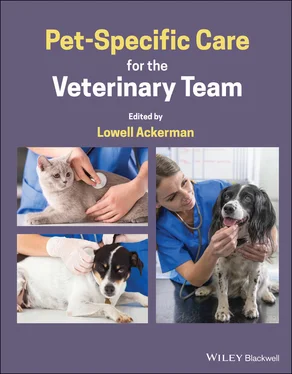 TAKE‐AWAYS
TAKE‐AWAYS
Underrecognized and undermanaged pain inflicts very real physiological and medical consequences, resulting in significant patient morbidity and in the extreme can contribute to mortality.
Through the process of peripheral and central hypersensitization (“wind‐up”), pain becomes maladaptive, exaggerated in scope, severity, character, duration, and field; a number of factors will place a patient at risk for maladaptive pain, including (but not limited to) nerve injury, severe trauma, chronic inflammation, heritable tendency.
Assessment of both acute postsurgical and chronic OA‐related pain is possible with validated CMIs.
Evidence‐based industry guidelines and consensus statements are available to direct veterinary clinicians to the highest, wisest, safest multimodal strategies for acute and chronic pain.
Veterinarians are advised to adopt the emerging trend of reducing, full mu agonist opioid usage, insofar as possible and still maintain patient comfort, in favor of buprenorphine and butorphanol along with multiple opioid‐sparing modalities and strategies.
 MISCELLANEOUS
MISCELLANEOUS
2.16.5 Cautions
With an aggressive multimodal approach to peri‐perative pain management, anesthetic requirements may be significantly reduced; adjust induction doses and vaporizer settings accordingly.
BCSBody condition score
1 1 Bonica, J.J. (1979). International for the study of pain: pain definition. The need of a taxonomy. Pain 6 (3): 247–248.
2 2 Tony Buffington, C.A., Westropp, J.L., and Chew, D.J. (2014). From FUS to Pandora syndrome: where are we, how did we get here, and where to now? J. Feline Med. Surg. 16 (5): 385–394.
3 3 Mathews, K., Kronen, P.W., Lascelles, D. et al. (2014). Guidelines for recognition, assessment and treatment of pain: WSAVA Global Pain Council. J. Small Anim. Pract. 55 (6): E10–E68.
4 4 Epstein, M., Rodan, I., Griffenhagen, G. et al. (2015). 2015 AAHA/AAFP pain management guidelines for dogs and cats. J. Am. Anim. Hosp. Assoc. 51 (2): 67–84.
5 5 Muir, W.W., Berry, J., Boothe, D.M., et al. (2018). Opioid‐Sparing Pain Therapy in Animals: Working Task Force. https://ivapm.org/wp‐content/uploads/2018/12/Op‐Sparring‐Task‐Force‐WP.pdf
6 6 Fan, T.M., de Lorimier, L.P., O'Dell‐Anderson, K. et al. (2007). Single‐agent pamidronate for palliative therapy of canine appendicular osteosarcoma bone pain. J. Vet. Intern. Med. 21 (3): 431–439.
7 7 Ray, L., Lipton, R.B., Zimmerman, M.E. et al. (2011). Mechanisms of association between obesity and chronic pain in the elderly. Pain 152 (1): 53–59.
1 Rodan, I., Sundahl, E., and Carney, H. (2011). AAFP and ISFM feline‐friendly handling guidelines. J. Feline Med. Surg. 13 (5): 364–375.et al., for the American Animal Hospital Association
2 Yin, S. (2009). Low Stress Handling, Restraint and Behavior Modification of Dogs and Cats: Techniques for Developing Patients Who Love Their Visits. Davis, CA: Cattledog Publishing.
2.17 Emergency Preparedness
Lori Massin Teller, DVM, BS (Vet Sci), DABVP (Canine/Feline Practice)
Department of Small Animal Clinical Sciences, College of Veterinary Medicine & Biomedical Sciences, Texas A&M University, College Station, TX, USA
 BASICS
BASICS
2.17.1 Summary
Disasters, man‐made or natural, can be devastating. Lives can be disrupted or lost, property damaged or destroyed. It is important to prepare yourself, your family, your clients, and your practice ahead of time for a disaster. There are some disasters that you may be forewarned about, such as hurricanes or blizzards. Others may happen without warning, such as earthquakes, tornadoes, fires, or terrorist attacks. Disaster plans should include contingencies for both local emergencies, such as a building fire or flooding from a burst water main, as well as a community‐wide event, such as a chemical spill or massive flooding from a hurricane or wind damage from a tornado. It is vitally important that veterinary practices have a written disaster plan to cover emergency relocation of animals, back‐up of medical records, continuity of operations, security, fire prevention, and insurance and legal issues.
Incident Command System ( ICS ):Defined command and control system to manage the emergency. Activities of all responding agencies and people are coordinated through the ICS.
 MAIN CONCEPTS
MAIN CONCEPTS
For disasters in which there is forewarning, such as hurricanes or blizzards, it is important for veterinarians and staff to have their personal preparations, including plans for family, animals, and property, stabilized before they can focus on the business. Take care of self, then family, then the practice, then others to ensure a successful disaster response.
For practices affected by a disaster, first and foremost there needs to be an evacuation plan for people and animals. Identify locations outside the danger zone to which animals can be relocated. These locations may need to be in multiple directions and at varying distances from the practice. If the disaster is contained to the practice facility, then animals may be located to a building next door or down the street. A disaster that affects the neighborhood, such as a chemical spill, may require relocating animals several miles away. Partner with other practices with a reciprocity agreement and/or contact local community centers. Determine ahead of time where animals will be placed within these facilities, so that dogs and cats can be separated, and animals requiring medical attention can be placed in a makeshift ward away from those which just need their basic needs met. Be prepared ahead of time for the evacuation by having plenty of leashes, carriers, and feeding supplies. Prearrange transportation to the facility. Make sure each animal has some sort of identification (ID). Have a contact list of animal owners available, preferably stored offsite. This may be part of medical records and practice management information that is stored in a remote location, not on the premises.
It can be complicated when local practices become a holding place for displaced animals that come in without an identified owner. There is not an established veterinarian–client–patient relationship (VCPR) to allow for anything beyond emergency treatment or for disposal of the animal after a set time if an owner never comes forward. This comes with the potential for significant expense and legal liability risks. These expenses are not likely to be reimbursed by emergency services (such as Federal Emergency Management Administration [FEMA] in the United States) or other governmental entity. Local veterinarians should encourage their city or county to have a disaster plan that includes the handling and housing of displaced animals. Veterinarians should be included in the larger local or state government's disaster planning, and a veterinarian should have a role in the ICS.
Читать дальше

 TAKE‐AWAYS
TAKE‐AWAYS MISCELLANEOUS
MISCELLANEOUS BASICS
BASICS MAIN CONCEPTS
MAIN CONCEPTS










